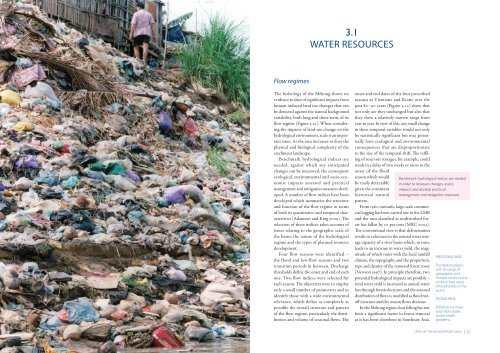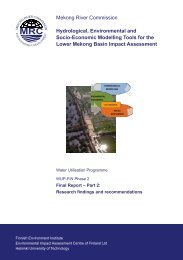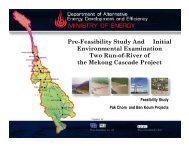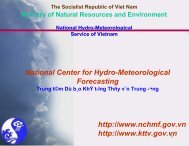download - Mekong River Commission
download - Mekong River Commission
download - Mekong River Commission
Create successful ePaper yourself
Turn your PDF publications into a flip-book with our unique Google optimized e-Paper software.
Flow regimes<br />
3.1<br />
WATER RESOURCES<br />
The hydrology of the <strong>Mekong</strong> shows no<br />
evidence to date of significant impacts from<br />
human induced land use changes that can<br />
be detected against the natural background<br />
variability, both long and short-term, of its<br />
flow regime (Figure 3.1.1). When considering<br />
the impacts of land-use change on the<br />
hydrological environment, scale is an important<br />
issue. As the area increases so does the<br />
physical and biological complexity of the<br />
catchment landscape.<br />
Benchmark hydrological indices are<br />
needed, against which any anticipated<br />
changes can be measured, the consequent<br />
ecological, environmental and socio-economic<br />
impacts assessed and practical<br />
management and mitigation measures developed.<br />
A number of flow indices have been<br />
developed which summarise the structure<br />
and function of the flow regime in terms<br />
of both its quantitative and temporal characteristics<br />
(Adamson and King 2009). The<br />
selection of these indices takes account of<br />
issues relating to the geographic scale of<br />
the basin, the nature of the hydrological<br />
regime and the types of planned resource<br />
development.<br />
Four flow seasons were identified –<br />
the flood and low-flow seasons and two<br />
transition periods in between. Discharge<br />
thresholds define the onset and end of each<br />
one. Two flow indices were selected for<br />
each season. The objectives were to employ<br />
only a small number of parameters and to<br />
identify those with a wide environmental<br />
relevance, which define as completely as<br />
possible the overall structure and pattern<br />
of the flow regime, particularly the distribution<br />
and volume of seasonal flows. The<br />
onset and end dates of the four prescribed<br />
seasons at Vientiane and Kratie over the<br />
past 80–90 years (Figure 3.1.2) show that<br />
not only are they unchanged but also that<br />
they show a relatively narrow range from<br />
year to year. In view of this, any small change<br />
in these temporal variables would not only<br />
be statistically significant but may potentially<br />
have ecological and environmental<br />
consequences that are disproportionate<br />
to the size of the temporal shift. The refilling<br />
of reservoir storages, for example, could<br />
result in a delay of two weeks or more to the<br />
onset of the flood<br />
season which would<br />
be easily detectable<br />
given the consistent<br />
historical natural<br />
pattern.<br />
From 1960 onwards, large-scale commercial<br />
logging has been carried out in the LMB<br />
and the area classified as undisturbed forest<br />
has fallen by 20 per cent (MRC 2003).<br />
The conventional view is that deforestation<br />
results in a decrease in the natural water storage<br />
capacity of a river basin which, in turn,<br />
leads to an increase in water yield, the magnitude<br />
of which varies with the local rainfall<br />
climate, the topography and the proportion,<br />
type and density of the removed forest cover<br />
(Newson 1997). In principle therefore, two<br />
potential hydrological impacts are possible –<br />
total water yield is increased as annual water<br />
loss through forests decreases and the seasonal<br />
distribution of flows is modified as flood runoff<br />
increases and dry season flows decrease.<br />
In the <strong>Mekong</strong> region clear felling has not<br />
been a significant factor in forest removal<br />
as it has been elsewhere in Southeast Asia.<br />
Benchmark hydrological indices are needed<br />
in order to measure changes, assess<br />
impacts and develop practical<br />
management and mitigation measures<br />
PRECEDING PAGE<br />
The <strong>Mekong</strong> Basin,<br />
with its range of<br />
geographic and<br />
climatic zones, is one<br />
of the richest areas<br />
of biodiversity in the<br />
world.<br />
FACING PAGE<br />
Pollution is a major<br />
issue that creates<br />
severe health<br />
problems.<br />
STATE OF THE BASIN REPORT 2010 | 57






